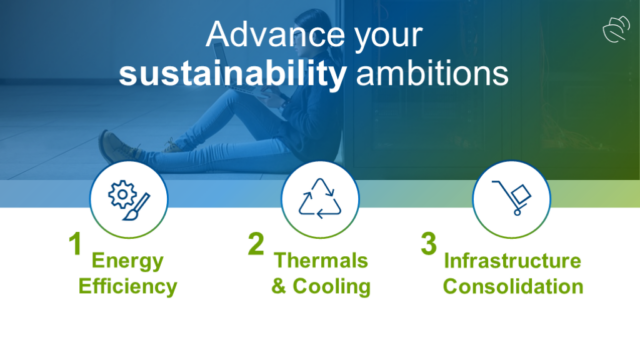Enterprise Strategy Group research confirms that IT departments are very active in driving environmental, social and governance (ESG) initiatives. According to the leading research firm, 93 percent of those surveyed said the IT supplier’s ESG program will have a significant or modest impact on their IT purchase decisions.1
Combine that with the most significant energy price increases the world has seen in five decades, and the fact that data centers consume approximately 200 terawatt-hours (TWh) of electricity, which is nearly 1% of all global electricity demand, it comes as no surprise that implementing a green data center and hitting the “Environmental” aspect of ESG is top of mind for IT decision makers.
Going green and having a sound sustainability focus is and should be a key element of every company’s ESG efforts, but what matters most is doing business with a company that you trust. Dell is proud of our ESG efforts – we believe it is and must be more than an initiative – it’s a way of doing business. We demonstrate this commitment by publishing our ambitious goals in our annual ESG Report. This report gives our customers a complete 360 degree view of our ESG efforts, from cultivating inclusion, transforming lives and upholding ethics and privacy to how we’re advancing sustainability with goals including:
-
- By 2030, for every product a customer buys, we will reuse or recycle an equivalent product.
- By 2030, 100% of our packaging will be made from recycled or renewable material, and more than half of our product content will be made from recycled or renewable material.
- By 2030, we will source 75% of electricity from renewable sources across all Dell Technologies facilities — and 100% by 2040
- We will reach net zero greenhouse gas (GHG) emissions across Scopes 1, 2 and 3 by 2050
These goals give our customers the confidence we are invested for the long term in meeting their sustainability needs. We are also helping them focus on sustainability for today to meet rising energy costs or with countries like Singapore, where they are establishing very strict efficiency guidelines for new data centers – from power and cooling to IT system efficiency.
At the heart of data center efficiency and sustainability is data. Businesses are bracing themselves for zettabytes of data to manage. Findings from Dell’s Data Paradox Study reveal that for many organizations, data will become a burden rather than an opportunity.
That’s where modern storage comes in. And there are three ways Dell’s modern storage portfolio advances sustainability: Energy efficiency, Thermals and cooling and Infrastructure consolidation.
 Energy Efficiency
Energy Efficiency
First, we’re reducing the energy intensity of our technology and making it more efficient with each new generation. That means delivering more power efficiency while certifying that our systems use industry standard benchmarks including ENERGY STAR and EPEAT (Electronic Product Environmental Assessment Tool).
Our latest Dell storage innovations exemplify this. PowerMax delivers 80% power savings per TB2 and up to 7X more capacity per array in half the rack space3 – compared with previous generation. All this while maintaining 99.9999% availability.4 And Dell PowerStore 3.0 delivers up to 60% more IOPS per watt.5
Many Dell storage offerings, as well as Dell HCI, are ENERGY STAR Certified – so that the energy efficiency part of the purchasing decision is done for you. And to align purchasing of our HCI systems with your sustainability IT goals, Dell PowerEdge offers 43 EPEAT registered products.
Thermals and Cooling
Next, we’re revolutionizing thermals and cooling to improve efficiency and reduce heat as we increase system processing – all while enhancing performance.
Dell storage is architected for adaptive cooling to reduce energy consumption. Our fans speed up as environmental temperatures rise, or CPU usage increases, to maintain optimal temperatures without using any more energy than needed.
Most Dell storage and server products will have at least one Titanium PSU offering by 2023. Titanium power supply units (PSUs), ranked by the 80 PLUS program, use less electricity to power the server and emit less heat, which results in significant energy savings on cooling.
Infrastructure Consolidation
Finally, our storage helps you consolidate your infrastructure so you can reduce the physical and carbon footprint in your data center.
According to a recent Forrester study, customers overprovision their storage environment by an average of 37%. With Dell innovations like data reduction and high-density flash drives – you can avoid overprovisioning by doing more with less – less raw storage capacity required, less energy and cooling and less hardware.
To increase data density, Dell guarantees data reduction across our broad storage portfolio, while helping you get the most value from flash media. Specifically, Dell guarantees a 4:1 reduction ratio across its PowerStore and latest PowerMax Open Systems platforms, with no pre-assessment required.6
In fact, the entire PowerStore portfolio offers superior data density when compared with a family of equivalent all-flash arrays from a competitive vendor.7 Better data density helps you reduce your carbon footprint by maximizing the effective terabyte per rack unit.
Take the example of the AIDS Healthcare Foundation (AHF). AHF does incredible work providing cutting-edge medicine and advocacy to more than a million people in 45 countries. By introducing Dell PowerMax into their aging storage infrastructure, the organization reduced its physical footprint in the data center by 88%, from two racks to a quarter of a rack, which then helped drive down power and cooling costs by more than 50%.
Advancing Sustainability, Together
At Dell Technologies, our vision is to become the most essential technology company for the data era. We’re doing this by redefining IT with an open and modern software-defined architecture designed for the digital future, providing our customers with the simplicity, agility, and control of their technology, which leads to improved business outcomes in the aaS, distributed and multicloud world.
We also believe strongly that it’s every technology provider’s responsibility to prioritize environmental sustainability and to deliver technology that will drive human progress. And it’s important for you to understand how our ESG efforts – at the industry, company, portfolio and product level – support your own sustainability ambitions.
Beyond our storage sustainability features, the Dell Future Proof program (including Tech Refresh and Recycle) and Dell APEX aaS offerings give you even more innovative ways for sustainably managing your IT infrastructure.
Together, we can advance sustainability. For more information on Dell’s commitment to advancing sustainability please visit us online.
1 ESG Complete Survey Results, The Role of ESG Programs in IT Decision Making, September 2022.
2 Based on Dell’s internal analysis comparing power (kVA) per effective terabyte of the PowerMax 2500 compared with the PowerMax 2000, March 2022.
3 Based on Dell’s internal analysis comparing Effective Storage Capacity of the PowerMax 2500 compared with the PowerMax 2000, March 2022. Actual storage capacities will vary.
4 Based on Dell’s PowerMax specification for a single PowerMax 2000, 2500, 8000, or 8500 array, March 2022. Actual data availability will vary.
5 Based on Dell analysis comparing maximum IOPS per Watt for PowerStore 1200 base appliance configurations with PowerStoreOS 3.0 vs. PowerStore 1000 base appliance configuration with PowerStoreOS 2.0. Actual results vary.
6 PowerStore and PowerMax OS: 4:1 average rate guaranteed across customer applications. Rates for individual applications may vary. See Future-Proof program terms and conditions for details.
7 Based on Dell analysis comparing maximum effective capacities of PowerStore and equivalent all-flash array platforms from a competitive vendor. Assumes average 4:1 data reduction. for PowerStore, 5:1 for competitive arrays. Actual results may vary.


